Background Info
In case you are interested in what is going on under the hood of using sconectl to build confidential container images and confidential applications, we explain the steps in some more details below. During the workshop, we will introduce these aspects in some details.
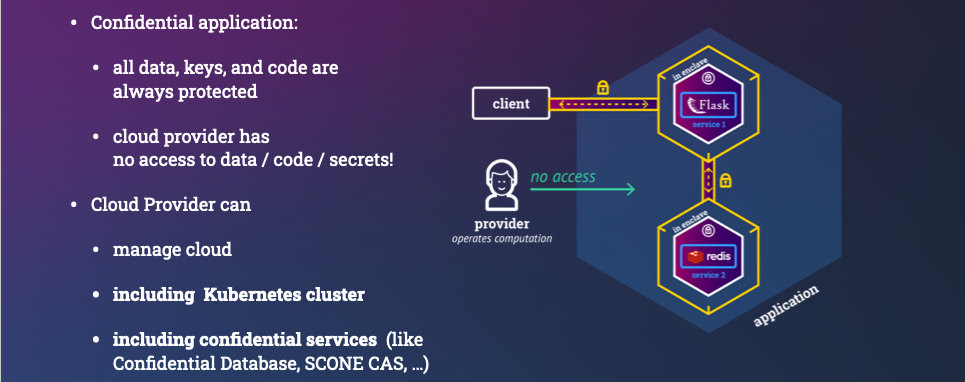
Building a Confidential Image
Our objective is to build a confidential container image to run this application in an encrypted memory region (a.k.a. enclave) and ensure that environment variables are securely passed to the application only after the application was attested and verified. Otherwise, one could, by changing the arguments passed to a Python engine, run completely different functionality.
Note that we want to outsource the management of Kubernetes to an external provider. Hence, we do not want Kubernetes nor any Kubernetes admin to be able to see the value of our environment variables - at no time: neither during the runtime nor during the startup time. Of course, only our original Python program should be able to be able to access the value. Any modification of the Python program must be detected.
Note also that the cloud provider takes care of the integrity of the Kubernetes cluster using traditional isolation mechanisms (e.g., isolation using VMs and containers). Kubernetes will not have access to any data, code, or key material of the application: their confidentiality, integrity and freshness will all be protected by SCONE.
The Manifest Files
We can build a confidential container images and applications consisting of multiple container images with the help of a manifests:
Meshfile: describes how to build an application consisting of one or more images. This is defined by the application owner. This can define values that need to be integrity and freshness protected. We should avoid to define values that need to be confidential since admins of the application owner might see the meshfile.
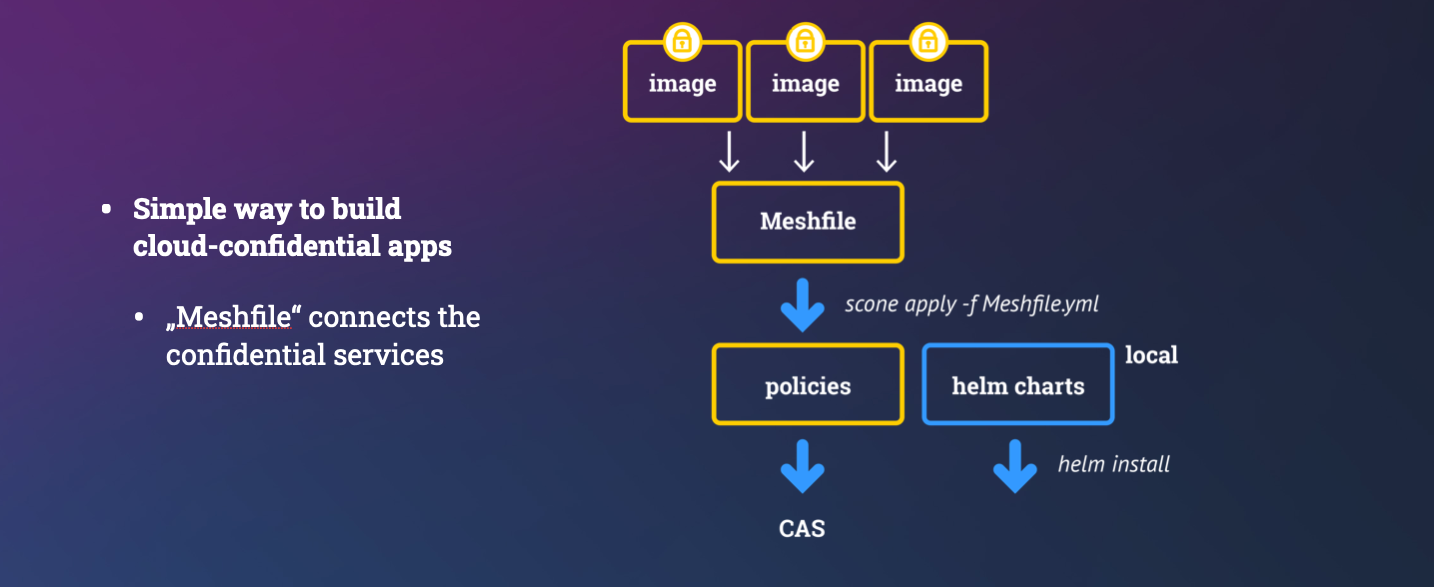
service manifest: describes how to build a confidential image to deploy a confidential service. For example, we want to run a Python program inside an enclave. Thisservice manifestis defined by the application or service owner.

security policy: describes how to attest a service and to provision secrets / configuration to a service instance. This is automatically derived form themeshfileandservice file. It can generate secrets that now admin can see. These secrets can be generated inside of an enclave or these secrets can be retrieved from an external key store like a HSM.
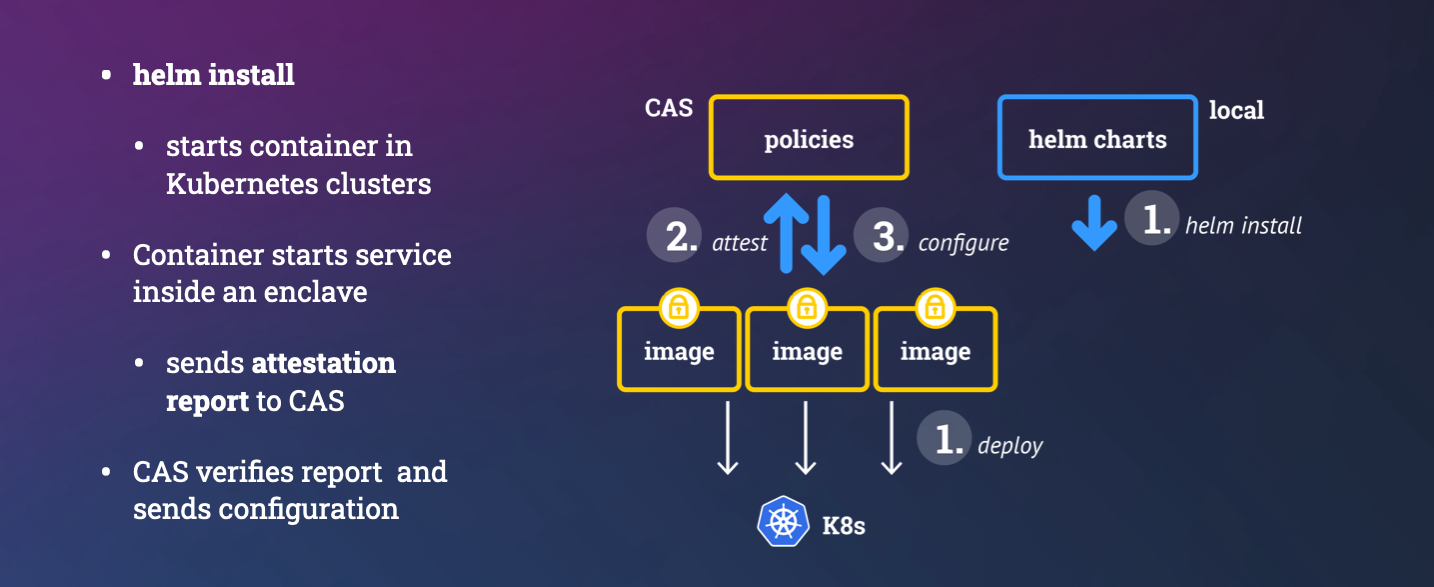
Service Manifest
Our Python program uses environment variables that need to be protected:
API_USERis an environment variable that is defined in theMeshfile. Hence, we add it to theglobalsection. We could define a default value in the service manifest. This variable is integrity protected. While a cloud provider would not be able to see the value, an admin of the application owner might be able to see this. (Note that our Python program prints this value on the console indicating that we only want to protect its integrity).

API_PASSWORDis an API password and should not be known by anybody - not even an admin by the application owner. Hence, we ask SCONE CAS (Configuration and Attestation Service) to randomly select it inside an enclave.- We define a secret with name
passwordas part of the secrets section. This has a length of 10 characters that are randomly selected by SCONE CAS. - The value of this secret can be referred to by "$$SCONE::password". This value is only available for our Python program. In general, we recommend to share secrets amongst the services of the same application mesh only.
- We define this locally in the manifest for this service. Hence, we define it in section
local- this cannot be modified in theMeshfile(i.e., a manifest that describes how to connect services).
We build the confidential container image with the help of the build section:
name: set the name of the service deployed with this container image.kind: `Python says that we need a Python engine to execute this programto: is the name of the generated imagepwd: the working directory in which our Python program will be locatedcommand: this is the command line. This is protected to ensure that an adversary cannot change the arguments of our program. Changing the arguments would permit the adversary, for example, to print the value of the environment variables.copy: a list of files or directories to copy into the image.
apiVersion: scone/5.8
kind: genservice
# define environment variables
# - local ones are only visible for this service
# - global ones are defined for all services in a mesh
environment:
local:
- name: SCONE_HEAP
value: 760M
- name: SCONE_LOG
value: error
- name: API_PASSWORD
value: "$$SCONE::password$$" # get from CAS
global: # values defined/overwritten in Meshfile
- name: API_USER # get value from Meshfile
# define secrets that are managed by CAS
secrets:
global:
- name: password
kind: ascii
size: 10
build:
name: python_hello_user
kind: python
to: registry.scontain.com/cicd/python_hello_user:latest
pwd: /python
command: python3 print_env.py
copy:
- print_env.py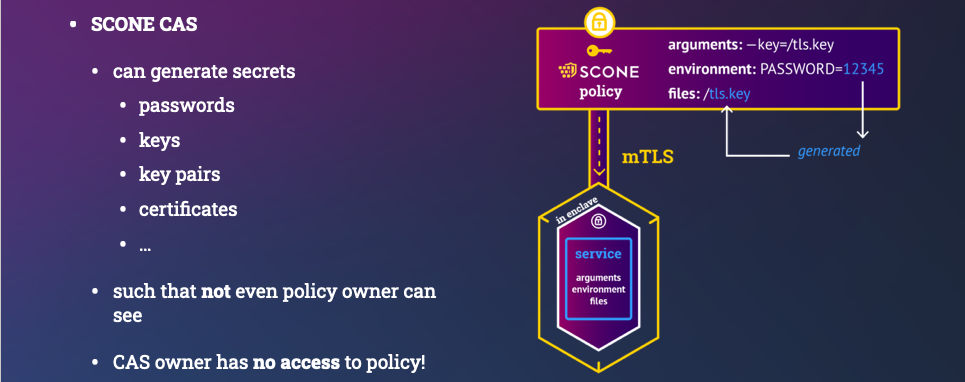
NOTE: You do not need a service manifest for curated confidential service like
memcached,nginx,MariaDB, etc, since the images already contain all required information.NOTE: We typically use one repository near the Kubernetes cluster to store all images. We protect the access to this repo using a Kubernetes secret. Typically, we use a secret called
sconeapps,
Application Mesh Manifest (aka Meshfile)
A cloud-native application typically consists of multiple services. In this example, we start with one service.
To run an application, we need to specify which CAS instance we want to use. Actually, we typically can use multiple CAS instances for various aspects.
Each application must define its own unique CAS namespace. This could have the same name as the namespace that we use to run this application in Kubernetes.
We can define the environment variables that are marked as global by the individual services. If no default value was given, we must define a value here.
The service section describes the set of services from which this application is composed of:
name: is a unique name of this serviceimage: is the name of the image.
apiVersion: scone/5.8
kind: mesh
cas:
- name: cas # cas used to store the policy of this application
alias: ["image", "security", "access", "attestation"] # use alias in case CAS instance has multiple roles
cas_url: edge.scone-cas.cf # exported as {{cas_cas_cas_url}}
tolerance: "--only_for_testing-trust-any --only_for_testing-debug --only_for_testing-ignore-signer -C -G -S"
policy:
namespace: myPythonApp # namespace on CAS instance `cas`
# define environment variables
env:
- name: API_USER
value: myself
- name: imagePullSecrets
value: SconeApps
- name: APP_SERVICE_PORT
value: 443
services:
- name: pythonapp
image: registry.scontain.com/cicd/python_hello_user:latestArtifacts
We use different services to store the generated artifacts:
- SCONE CAS stores the policies. SCONE CAS runs inside of an enclave. It is attested before uploading a policy. It is a trusted entity.

- Image repository stores container images. We do not need to trust the image repository regarding confidentiality, integrity, or consistency. We expect that an image repository has sufficient availability.
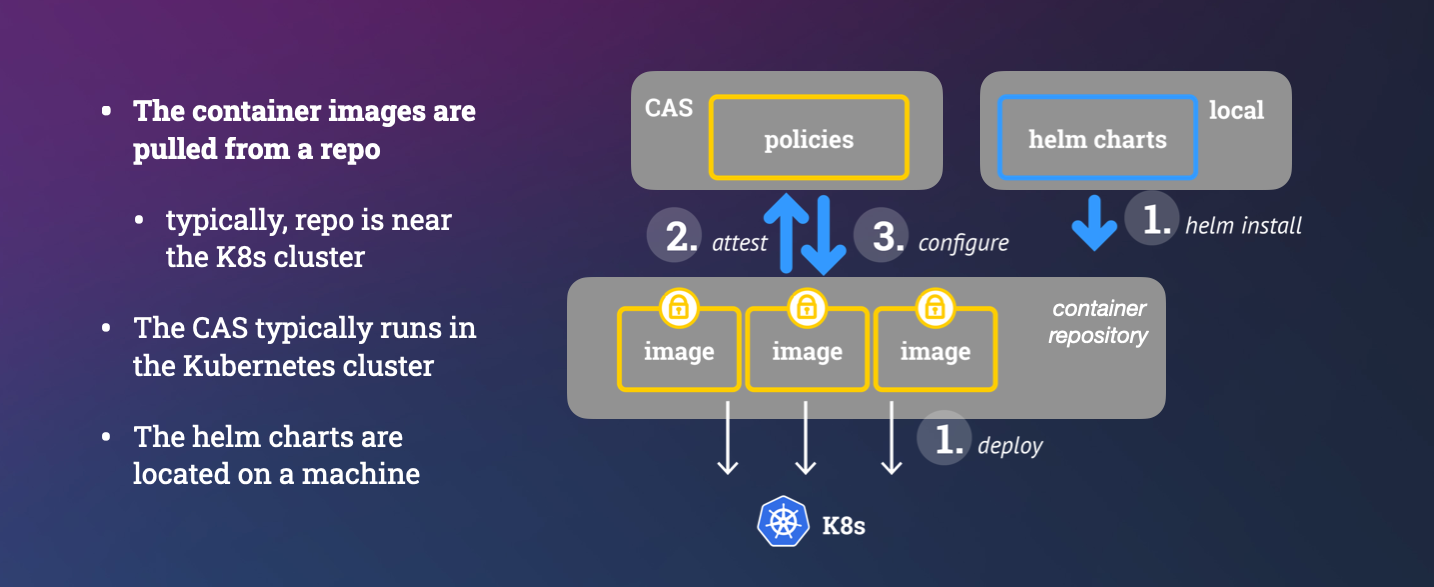
- We use
helmto install confidential services. We do not trust helm to protect the confidentiality, integrity or consistency.